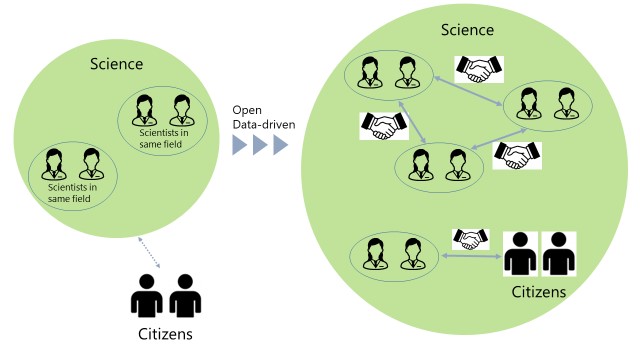Presenter: Taro Miyauchi
Date: July 14th, 2022
Part presented: Chapter 7. Promoting data-driven scientific research
Keywords: open science / citizen science / infrastructure development for data sharing
- Summary of this chapter
In this chapter, authors focused on “science” and mentioned the relationship with “data-driven” or “open data”. It was said that data became open and “data-driven” was introduced more in science field, due to ICTs. This circumstance was called “open science”. “Open science” can cause to connect between scientists all over the world, and it contributed to solve the global scale problems: environment, climate change, ageing, population, health, etc. Data-driven can be detect complex patterns and invisible relationships, so it also had good effects to some scientific fields to do traditional lab experiments which were difficult or impossible to do them before. As data opened, more scientists can connect each other not only in same fields but also across fields. Like them, data-driven and open-data were introduced more and more, and it had positive effects in science, not only technology but also the relationships between researchers.
In addition to them, they effected the relationship between science and citizen. As data was more opened, citizens joined the process of science more. This situation was called “citizen science”. It can not only get trusts from citizens in science, but also have good effect to the results and outcome of science. Like this, through “open” and “data-driven”, it was changed from “there were connections only between the scientists who were in same fields” to “there were connections, not only between the scientists across the fields, but also between scientists and citizens”, like figure 1.
Recently, more and more OECD or other countries tried to utilize open data or data-driven. Many examples of them were introduced in the final section of this chapter.
Figure 1. Connections between scientists in different fields, and between science and citizens were created due to open data and data-driven.
- Discussion
After the presentation, we discussed 2 things. First, we considered we had experienced or heard kinds of “citizen science”. For example, some of us took the course of Dr. Murayama and Nishikizawa, “environmental assessment”. In this lecture, it was mentioned that Administrators, specialists, and local people discussed when something such as solar panels were built in a city. Then, locals attended actively to those discussions and expressed their opinion well, and they were sometimes accepted. We thought it were one of “citizen science”. In addition, when we searched citizen science on the internet, we found we can see the examples of citizen science in the fields of Biology and Ecology well. We thought it was because it was easier to get the knowledge of them and understand for citizens, compared to other scientific fields. We also considered that it was also related to it that it was sometimes related to citizens’ lives, and more citizens were interested in those fields. According to one student, in an Asian country, kind of citizen science had been introduced to water management. To manage, it was necessary to know some special knowledge, but through the process of this project, citizens learned the expertise and finally they can run by themselves. It was an example of citizens being able to join the area of expertise and completing efficiency. In the paper, it was said that it was facilitated to call to younger ages to join science as citizens in education. However, all of us have never experienced them.
Then, we discussed how much citizen science is acceptable. To consider science, there was an opinion that it became important to have some knowledge of the science field. But citizen joining sometimes did not have them, and we considered it inhibited the progress of science and technologies if those ignorant citizens joined. On the other hand, as we discussed at first topic, there were some fields which were easier for citizens to join like Biology, Ecology, etc. and more new findings were happened if citizens joined in science. And citizens can get knowledge of the fields and utilize them if they learn, even they did not have the knowledge first, and it was related to efficiency. So finally, as in the opinion of the book, our conclusion was that no small amount of citizen intervention is essential for development.
Especially in the fields of disaster prevention, we were keenly aware of the need for citizen science. There was a member in us who researched disaster prevention, and she said that citizens joining was necessary to reduce the damages of disasters. It was easier for citizens to join itself and attend the process of plan, but it was difficult for them in the process of evaluation (we thought we can say same thing to other fields). In the field of disaster prevention, it was also important for citizens to get the information of disaster thorough media, talking with neighbors, and so on, but it was a challenge that some of the information sometimes wrong. Then, it was important to make it easy to access hazard information like hazard map for local people.
In any event, we concluded it was necessary for science that citizens join and we should seek the method of them or something which can efficient for citizens to join.
